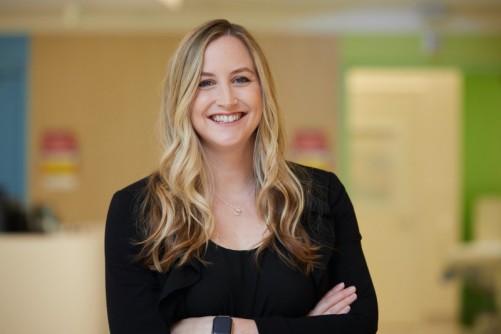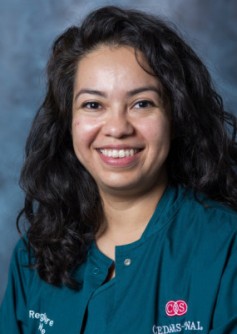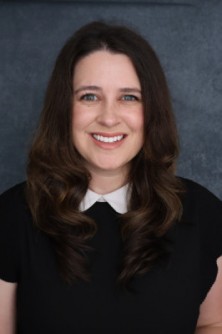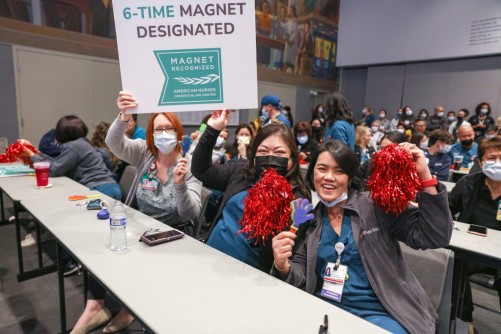Throughout the COVID-19 pandemic, more than 3,200 Cedars-Sinai Medical Center nurses put on their protective gear and kept on going—providing the highest-quality patient care, conducting innovative research and creating new ways for patients to conveniently access Cedars-Sinai experts.
Here's a look at a few of these heroes and how they’re doing now that the pandemic is waning, and what they’re finding most rewarding as they continue their work on the front line.

Maureen Chin, RN, associate director, Department of Pediatrics, Guerin Children’s
Chin spent much of the pandemic planning for the opening of the Guerin Children's in the summer of 2022. The new facility offers highly specialized care for children of all ages and spans neonatology, gastroenterology, cardiac services, orthopedics, neurology and beyond.
Chin has spent her career at Cedars-Sinai Medical Center and is accustomed to a bustling atmosphere. But she was surprised at how quickly patient volume increased at Guerin Children’s.
“The number of patients doubled within weeks,” she said. “Then respiratory season came, and again, we had record-breaking admissions. We were also getting calls every day from all over the region about having patients transferred here. I was proud of our team for keeping the patient care flow moving.”
A year after opening its doors, Guerin Children’s has newly expanded services, including halo-gravity traction, which gently stretches and straightens the spine, as well as increased epilepsy monitoring.
“Our nurses are masters in varied types of specialized care, from oncology conditions to seizure disorders to trauma,” Chin said. “Then there are the outpatient clinics that are a part of the Guerin Children’s family. It’s quite expansive.”
When Chin has a rare free moment, she heads to the Healing Garden at Guerin Children’s. It was created to bring tranquility to patients, their families and staff members. Chin calls it an “instant mood-lifter.”
Another boost to the spirits comes when Chin brings a friendly volunteer to work with her: Rhone, her 2-year-old certified therapy dog. “Rhone brings a smile to everyone’s face—kids, parents and staff.”
The most fulfilling event for Chin, though, is when a young patient leaves the hospital.
“Kids are so resilient—often, they go home better than I could’ve ever imagined. And that’s the best feeling.”

Paulina Andujo, RN, clinical joint surgery manager in the Joint Replacement Program
Andujo turned to music to get through the pandemic and even learned a new skill to help her co-workers escape the intensity: DJing.
Throughout the pandemic, Andujo occasionally hosted virtual dance parties for her fellow caregivers. Now, she’s looking forward to an in-person party in the coming weeks. During National Hispanic Heritage Month, Andujo will DJ at a Cedars-Sinai celebration for nurses while they dance to the beat of “DJ Pau Pau.”
Now that the pandemic has eased, Andujo also is getting back to another passion—traveling on global volunteer missions with Operation Walk to provide joint replacement surgeries. Andujo recently returned from her seventh volunteer mission—this time, to Arusha, Tanzania, where 54 volunteer healthcare pros replaced 49 joints for 43 patients over three-and-half 13-hour days. They also collaborated with local hospital staff, helping patients in need as well as training the staff on surgical care techniques.
One patient was a 30-year-old man whose hip issues prevented him from working the hours he needed to support his family. He also couldn’t get down on the floor to play with his 4-month-old child. Hip replacement surgery changed everything.
“We’ve gotten pictures and videos from this patient since surgery,” Andujo said. “He has a light about him that wasn’t there before. As with many patients we meet on missions, being unable to work was detrimental to his livelihood and his relationships. We provide many patients their only opportunity to get surgery that can change their lives.”
Andujo is grateful to Cedars-Sinai for supporting her mission work.
“When I come back to work, everyone is eager to hear what I learned. It’s interesting to see what nursing looks like in other parts of the world. I can tell you that nursing care is nursing care, no matter what country.”

Kayla McBride, RN, digital care service nurse, Cedars-Sinai Virtual Second Opinion
McBride said the pandemic is partially responsible for the unique job she stepped into a year ago.
With the popularity of telehealth and virtual meetings increasing dramatically during the COVID-19 pandemic, McBride’s job is helping more patients than ever connect with Cedars-Sinai experts to get second opinions on the diagnoses or treatment recommendations they receive from their local physicians.
Cedars-Sinai’s Virtual Second Opinion is available to people in 20 states (more states continue to be added) who need complex cardiac, spine or gynecologic care. McBride is the first person with whom second opinion seekers connect when they enroll in the program. McBride's assessment to learn more about why a patient is seeking a second opinion is an in-depth conversation that can take more than an hour.
McBride partners with the patient to collect and organize their medical records and imaging, which are provided to a physician with specialized expertise. Within one to three weeks (depending on how long it takes to receive medical records), the patient gets a customized report with the physician’s feedback. Patients can review the report prior to their telehealth physician visit, and there are multiple opportunities to get questions answered.
McBride said that patients seek a second opinion from Cedars-Sinai for different reasons. Some patients simply want validation that what their first doctor recommended is a good treatment plan. Others want to know if there are breakthrough treatments on the horizon.
“We’re giving them access to one of the best opinions they can get,” she said. “Sometimes our opinion is that the patient doesn’t need the risky surgery, or that we can offer them a procedure that their local hospital wasn’t able to provide.”
Patients often tell McBride that they are comforted knowing that their voice is being heard.
“When patients say that we were great listeners and answered all their questions, that’s the extra cherry on top,” McBride said.
Source: Cedars-Sinai
